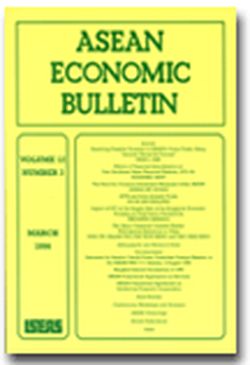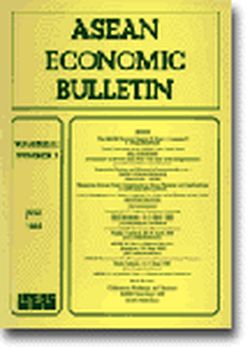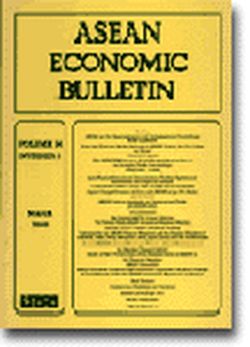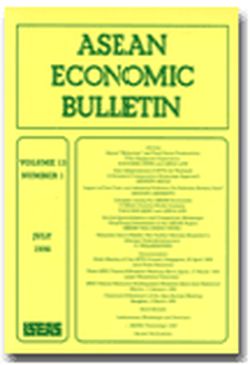ASEAN Economic Bulletin Vol. 12/3 (Mar 1996)

Date of publication:
March 1996
Publisher:
Institute of Southeast Asian Studies
Number of pages:
148
Code:
AE12/3
Contents
-
Preliminary pages
-
Resolving Possible Tensions in ASEAN's Future Trade Using "Analytic Hierarchy Process" see abstractThe article stipulates potential new conflicts between the Association of Southeast Asian Nations (ASEAN) and some trading partners due to allegations of âsocial dumpingâ and âeco dumpingâ that are seemingly unrelated to economic and trading matters but potentially can overcast the regionâs stable economies and buoyant trade performance. The nature and intensity of such conflicts are described in a quantitative manner by applying the Analytic Hierarchy Process (AHP) in a non-zero sum game framework. Subsequently, a number of alternative conditions within the context of dynamic games are explored. It is shown that a conflict resolution in terms of equilibrium co-operative solution can still be attained if policy makers are of a non-myopic type. When information asymmetry and element of uncertainty are taken into account, the article shows that ASEAN will be in a relatively better position.
-
Effects of Financial Liberalization on Four Southeast Asian Financial Markets, 1973-94, by Mohamed Ariff, contributor see abstractThis article measures the effects of international factors on domestic financial markets from financial liberalization in Indonesia, Malaysia, Singapore and Thailand over the last two decades. International factors significantly influenced financial markets in all these economies though at differing speeds and with varying degrees of openness depending on the extent of reforms. A brief summary of financial liberalization is provided to identify possible sources of the observed effects on financial markets. Our findings highlight the need to study the complementary role of current and capital account reforms that should accompany reforms in real sector and fiscal regimes in developing countries.
-
The Need for Common Investment Measures within ASEAN, by Denise Eby Konan, contributor see abstractA growing proportion of international trade within the Association of Southeast Asian Nations (ASEAN) occurs within multinational enterprises. In an effort to liberalize trade policy within the region, policies governing direct foreign investment should also be evaluated. ASEAN governments have achieved a significant level of convergence in investment policy regimes through unilateral reforms. One outcome of this non-cooperative approach, however, has been an unusually high level of investment incentives within ASEAN. This article evaluates investment regimes within ASEAN and considers the likelihood of a regional agreement on investment measures.
-
AFTA and Intra-Industry Trade, by Noor Aini Khalifah, contributor see abstractThis article provides an empirical analysis of intra-industry trade of the member states of the Association of Southeast Asian nations (ASEAN) for the period 1986â90. We demonstrate that ASEANâs intra-industry trade is conditioned by direct foreign investment consistent with industrial and export promotion policies of the member countries. Recent patterns of intra-industry trade in the ASEAN manufacturing sector show that Singaporeâs contribution is the highest followed by Malaysia, Thailand and Indonesia for 1990. To the extent that intra-industry trade is prevalent in ASEAN countries trade, trade adjustment within the ASEAN Free Trade Area (AFTA) will be easier than if inter-industry trade predominates. The results support the view that intra-industry trade is mainly for intermediate goods to satisfy finished goods producersâ demand for diverse components to contain cost. The results also imply that protectionist sentiment will be minimal within AFTA since both producer and consumer interests are at stake.
-
Impact of DFI on the Supply Side of the Singapore Economy: Focusing on Total Factor Productivity, by Hiromitsu Shimada, contributor see abstractThis study analyses the source of economic growth of Singapore, focusing on the different performance of foreign capital and local capital in its economy. After the mid-1980s, favourable growth induced by total factor productivity was led mainly by foreign companies, while local companies still were suffering from the delays in restructuring and new investment. Hence favourable spillover effects from foreign capital to local capital seem to be limited so far. Upgrading local companies to become excellent supporting industries is imperative in order to realize sustainable growth towards the next century.
-
The Asian Consumer Durable Market: With Special Reference to China, by Paul S L Yip, Gillian Yeo, Tan Teck Meng , Tan Chee Keng, contributors see abstractThe first part of this article investigates the overall size and growth potential of the Asian consumer market. The second part will concentrate on the consumer durable market, which is likely to out-perform the general consumer market, of individual Asian economies. Some of the durable markets are found to have strong potential while others are not that promising. The last part is a detailed study of individual consumer durable markets in China. China was chosen because of its huge market potential.
-
BIBLIOGRAPHIC AND RESEARCH NOTES: Australia-ASEAN Relations: A Guide to the Sources of Information, by Oliver Mann, author
-
DOCUMENTATION: Statement by Senator Gareth Evans, Australian Foreign Minister, to the ASEAN PMC 7+1 Session, on Australia, ASEAN and the East Asian Hemisphere, Bandar Seri Begawan, 2 August 1995
-
DOCUMENTATION: Bangkok Summit Declaration of 1995
-
DOCUMENTATION: ASEAN Framework Agreement on Services
-
DOCUMENTATION: ASEAN Framework Agreement on Intellectual Property Cooperation
-
BOOK REVIEW: Growth Triangles in Asia: A New Approach to Regional Economic Cooperation. Edited by Myo Thant, Min Tang and Hiroshi Kakazu
-
BOOK REVIEW: Malaysian Development: A Retrospective. By Martin Rudner
-
BOOK REVIEW: Vietnam and Japan: Japanese Investment and Aid Strategies in Vietnam: Implications for Development Directions. Edited by Barbara Duffield
-
Conferences, Workshops, and Seminars; ASEAN Chronology 1995; Recent Publications; Index





